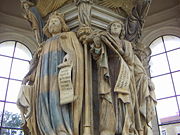
Claus Sluter
Encyclopedia

Netherlands
The Netherlands is a constituent country of the Kingdom of the Netherlands, located mainly in North-West Europe and with several islands in the Caribbean. Mainland Netherlands borders the North Sea to the north and west, Belgium to the south, and Germany to the east, and shares maritime borders...
origin. He was the most important northern European sculptor of his age and is considered a pioneer of the "northern realism" of the Early Netherlandish painting
Early Netherlandish painting
Early Netherlandish painting refers to the work of artists active in the Low Countries during the 15th- and early 16th-century Northern renaissance, especially in the flourishing Burgundian cities of Bruges and Ghent...
that came into full flower with the work of Jan van Eyck
Jan van Eyck
Jan van Eyck was a Flemish painter active in Bruges and considered one of the best Northern European painters of the 15th century....
and others in the next generation.
Sluter probably worked in Brussels
Brussels
Brussels , officially the Brussels Region or Brussels-Capital Region , is the capital of Belgium and the de facto capital of the European Union...
before moving to the Burgundian capital of Dijon
Dijon
Dijon is a city in eastern France, the capital of the Côte-d'Or département and of the Burgundy region.Dijon is the historical capital of the region of Burgundy. Population : 151,576 within the city limits; 250,516 for the greater Dijon area....
, where from 1385 to 1389 he was the assistant of Jean de Marville, Court Sculptor to Philip the Bold
Philip the Bold
Philip the Bold , also Philip II, Duke of Burgundy , was the fourth and youngest son of King John II of France and his wife, Bonne of Luxembourg. By his marriage to Margaret III, Countess of Flanders, he also became Count Philip II of Flanders, Count Philip IV of Artois and Count-Palatine Philip IV...
, Duke of Burgundy
Duke of Burgundy
Duke of Burgundy was a title borne by the rulers of the Duchy of Burgundy, a small portion of traditional lands of Burgundians west of river Saône which in 843 was allotted to Charles the Bald's kingdom of West Franks...
. From 1389 to his death he was Court Sculptor himself, with the rank of valet de chambre
Valet de chambre
Valet de chambre , or varlet de chambre, was a court appointment introduced in the late Middle Ages, common from the 14th century onwards. Royal Households had many persons appointed at any time...
. He was succeeded by his nephew Claus de Werve.
He restored the monumental scale and naturalism of the classical era to figural sculpture. His later work is highly emotional, using facial expressions, figural stance, and drapery; this can be particularly seen in the heavy folds of cloth that so many later imitators draped around their figures. His most famous surviving work is the Well of Moses
Well of Moses
The Well of Moses is a monumental sculpture recognised as the masterpiece of the Dutch artist Claus Sluter . It was executed by Sluter and his workshop in 1395–1403 for the Carthusian monastery of Chartreuse de Champmol built as a burial site by the Burgundian Duke Philip the Bold just outside the...
(1395–1403), created for the Carthusian
Carthusian
The Carthusian Order, also called the Order of St. Bruno, is a Roman Catholic religious order of enclosed monastics. The order was founded by Saint Bruno of Cologne in 1084 and includes both monks and nuns...
monastery
Monastery
Monastery denotes the building, or complex of buildings, that houses a room reserved for prayer as well as the domestic quarters and workplace of monastics, whether monks or nuns, and whether living in community or alone .Monasteries may vary greatly in size – a small dwelling accommodating only...
of Champmol
Champmol
The Chartreuse de Champmol, formally the Chartreuse de la Sainte-Trinité de Champmol, was a Carthusian monastery on the outskirts of Dijon, which is now in France, but in the 15th century was the capital of the Duchy of Burgundy...
built by Philip the Bold just outside Dijon (at the time - now part of the city). Sluter was also responsible for the main part of the work on Philip's tomb, which (restored and partly reconstructed) has been moved to the former ducal palace in Dijon.

